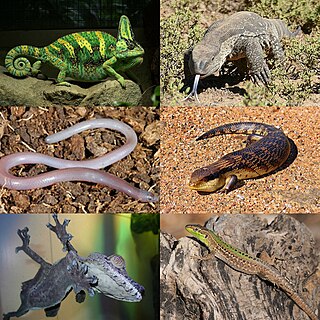
Lizards are a widespread group of squamate reptiles, with over 7,000 species, ranging across all continents except Antarctica, as well as most oceanic island chains. The group is paraphyletic since it excludes the snakes and Amphisbaenia although some lizards are more closely related to these two excluded groups than they are to other lizards. Lizards range in size from chameleons and geckos a few centimeters long to the 3-meter-long Komodo dragon.

Chameleons or chamaeleons are a distinctive and highly specialized clade of Old World lizards with 202 species described as of June 2015. The members of this family are most known for their distinct range of colors as they are able to shift in different hues and brightness. Because of the large number of species in their family, there is a large variability in their ability to change color. For some, it is more of a shift of brightness whereas others it is a plethora of combinations of colors.

Bradypodion is one of six genera of chameleons within the "true" or "typical" chameleons. They are native to southern Africa, and are sometimes collectively called South African dwarf chameleons. Some other small chameleons from eastern and central Africa are occasionally placed herein, but this is probably in error and not followed here. See also Systematics below and Kinyongia and Nadzikambia.

Calumma is a genus of chameleons endemic and restricted to Madagascar. The species formerly named Calumma tigris was transferred to the genus Archaius by Townsend et al., when they found that it is more closely related to Rieppeleon than to Calumma. The oldest fossil of the genus is known from the Early Miocene of Kenya, showing that the genus originated in Africa.

Brookesia is a genus of chameleons, endemic to Madagascar, that range from small to very small in size, and are known collectively as leaf chameleons. Brookesia includes species considered to be the world's smallest chameleons, and are also among the smallest reptiles. Members of the genus Brookesia are largely brown and most are essentially terrestrial.

Toxicofera is a proposed clade of scaled reptiles (squamates) that includes the Serpentes (snakes), Anguimorpha and Iguania. Toxicofera contains about 4,600 species, of extant Squamata. It encompasses all venomous reptile species, as well as numerous related non-venomous species. There is little morphological evidence to support this grouping, however it has been recovered by all molecular analyses as of 2012.
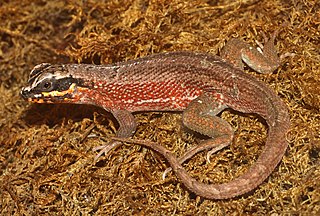
Iguania is an infraorder of squamate reptiles that includes iguanas, chameleons, agamids, and New World lizards like anoles and phrynosomatids. Using morphological features as a guide to evolutionary relationships, the Iguania are believed to form the sister group to the remainder of the Squamata, which comprise nearly 11,000 named species, roughly 2000 of which are iguanians. However, molecular information has placed Iguania well within the Squamata as sister taxa to the Anguimorpha and closely related to snakes. The order has been under debate and revisions after being classified by Charles Lewis Camp in 1923 due to difficulties finding adequate synapomorphic morphological characteristics. Most Iguanias are arboreal but there are several terrestrial groups. They usually have primitive fleshy, non-prehensile tongues, although the tongue is highly modified in chameleons. The group has a fossil record that extends back to the Early Jurassic. Today they are scattered occurring in Madagascar, the Fiji and Friendly Islands and Western Hemisphere.
Nasus is Latin for nose or snout, and appears in many related terms.
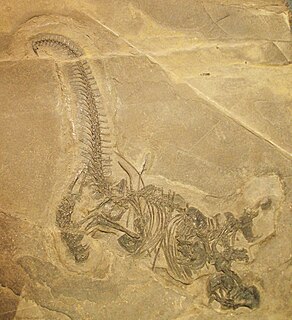
Drepanosaurs are a group of extinct reptiles that lived between the Carnian and Rhaetian stages of the late Triassic Period, approximately between 230 and 210 million years ago. The various species of drepanosaurid were characterized by specialized grasping limbs and often prehensile tails, adaptions for arboreal (tree-dwelling) and fossorial (digging) lifestyles, with some having also been suggested to be aquatic. Fossils of drepanosaurs have been found in Arizona, New Mexico, New Jersey, Utah, England, and northern Italy. The name is taken from the family's namesake genus Drepanosaurus, which means "sickle lizard", a reference to their strongly curved claws.
Albanerpeton is an extinct genus of salamander-like lissamphibian found in North America and Europe, first appearing in Cretaceous-aged strata. There are eight described members of the genus, and one undiagnosed species from the Paskapoo Formation, with the most recent, A. ektopistikon being described by Carrano et al.in 2022. Members of the genus had a robust head and neck which likely allowed them to actively burrow, characteristic of fossorial species, and they lived in a wide range of environments. This genus of amphibian was the last of its order, surviving until the late Pliocene in southern Europe, and into the Early Pleistocene (Gelasian) of northern Italy. It likely became extinct when the region developed its present Mediterranean-type climate, having preferred one that was cold and humid. The monophyly of Albanerpeton has recently been questioned

Ichthyosauridae is an extinct family of thunnosaur ichthyosaurs from the latest Triassic and Early Jurassic of Europe, and possibly also from the middle Early Cretaceous of Iraq. Named by Charles Lucien Bonaparte, in 1841, it is usually thought to contain a single genus, Ichthyosaurus, which is known from several species from the Early Jurassic. In 2013, Fischer et al. named and described Malawania anachronus from the middle Early Cretaceous of Iraq. It was found to share several synapomorphies with the type species of this family, Ichthyosaurus communis, and a large phylogenetic analysis recovered these species as sister taxa. Despite its geologically younger age, M. anachronus was also assigned to Ichthyosauridae.

Pholiotina is a genus of small agaric fungi. It was circumscribed by Swiss mycologist Victor Fayod in 1889 for Conocybe-like species with partial veils. The genus has since been expanded to include species lacking partial veils.

The Albanerpetontidae are an extinct family of small amphibians, native to the Northern Hemisphere during the Mesozoic and Cenozoic. The only members of the order Allocaudata, they are thought to be allied with living amphibians belonging to Lissamphibia. Despite a superficially salamander-like bodyform, their anatomy is strongly divergent from modern amphibians in numerous aspects. The fossil record of albanerpetontids spans over 160 million years from the Middle Jurassic to the beginning of the Pleistocene, about 2.13-2 million years ago.

Anolis barbatus is a species of anole lizard from Western Cuba. Adults have an average snout–vent length of up to 18 cm (7 in), with tails that are slightly shorter than their bodies, and demonstrate little sexual dimorphism. It is one of six species called "false chameleons" that sometimes are recognized as their own genus Chamaeleolis or as the Cuban clade in Xiphosurus. These are all native to Cuba, fairly large for anoles, have robust heads, are dull gray-brown in color, have blunt teeth used for crushing snails and insects, which are their main diet. Unusually among anoles, these all lack the ability to autotomize their tails. Together with the similar, but not closely related A. landestoyi of Hispaniola, they form a group known as the twig–giant ecomorph.
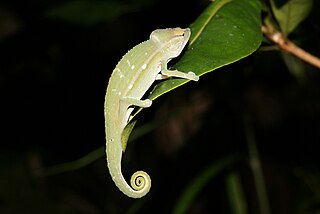
Chamaeleoninae is the nominotypical subfamily of chameleons. The Family Chamaeleonidae was divided into two subfamilies, Brookesiinae and Chamaeleoninae, by Klaver and Böhme in 1986. Since its erection in 1986, however, the validity of this subfamily designation has been the subject of much debate, although most phylogenetic studies support the notion that the pygmy chameleons of the subfamily Brookesiinae are not a monophyletic group. While some authorities have previously preferred to use the subfamilial classification on the basis of the absence of evidence principal, these authorities later abandoned this subfamilial division, no longer recognizing any subfamilies with the family Chamaeleonidae. In 2015, however, Glaw reworked the subfamilial division by placing only the genera Brookesia and Palleon within the Brookesiinae subfamily, with all other genera being placed in Chamaeleoninae.

The Family Chamaeleonidae was divided into two subfamilies, Brookesiinae and Chamaeleoninae, by Klaver and Böhme in 1986. Under this classification, Brookesiinae included the genera Brookesia and Rhampholeon, as well as the genera later split off from them. The Brookesiinae are small, often brown in colour, and occur in central Africa and Madagascar. They have terrestrial habits, or may be found in the lower levels of shrubs. Since its erection in 1986, however, the validity of this subfamily designation has been the subject of much debate, although most phylogenetic studies support the notion that the pygmy chameleons of the subfamily Brookesiinae are not a monophyletic group. While some authorities have previously preferred to use the subfamilial classification on the basis of the absence of evidence principal, these authorities later abandoned this subfamilial division, no longer recognizing any subfamilies with the family Chamaeleonidae. In 2015, however, Glaw reworked the subfamilial division by placing only the genera Brookesia and Palleon within the Brookesiinae subfamily, with all other genera being placed in Chamaeleoninae.
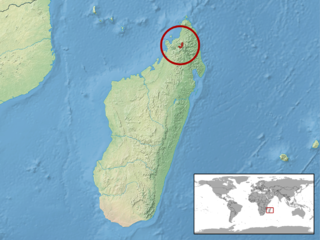
Palleon lolontany is a species of chameleon endemic to Madagascar. It was first described by Raxworthy and Nussbaum in 1995 as Brookesia lolontany. It was since placed in the genus Palleon when that genus was erected in 2013. The International Union for Conservation of Nature (IUCN) rated the species as Near Threatened.

Palleon nasus, commonly known as the elongate leaf chameleon, is a species of chameleon endemic to Madagascar. It was initially described by Boulenger in 1887. The species contains two subspecies, P. n. nasus and P. n. pauliani. It grows no more than 9 cm.

Barbaturex is an extinct genus of giant herbivorous iguanian lizards from the Eocene of Myanmar. It is represented by a single species, Barbaturex morrisoni, which is known from several partial dentaries and a fused pair of frontals, two bones that form part of the top of the skull. Based on the size of these bones, Barbaturex morrisoni is estimated to have been about 1 metre (3.3 ft) from snout to vent, and possibly up to 6 feet (1.8 m) including the tail. Barbaturex morrisoni was named after The Doors frontman Jim Morrison, a play on his epithet "The Lizard King". The genus's name is a portmanteau of the Latin words Barbatus and rex, meaning "bearded king", in reference to ridges along the mandible and the lizard's large size.
Scapanops is an extinct genus of dissorophid temnospondyl amphibian known from the Early Permian Nocona Formation of north-central Texas, United States. It contains only the type species Scapanops neglecta, which was named by Rainer R. Schoch and Hans-Dieter Sues in 2013. Scapanops differs from other dissorophids in having a very small skull table, which means that its eye sockets are unusually close to the back of the skull. The eye sockets are also very large and spaced far apart. Scapanops was probably small-bodied with a proportionally large head and short trunk and tail. Like other dissorophids, it probably spent most of its life on land.
















